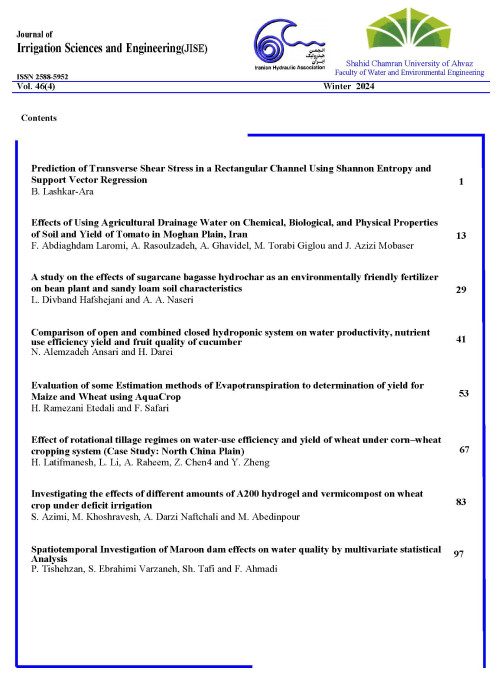Investigating the Performance of Data-based Methods in Estimating Important Moisture Points in Shahrood Area
Article Type:
Research/Original Article (دارای رتبه معتبر)
Abstract:
Awareness of the important moisture points is crucial for irrigation studies on the farm, but measuring this information in a direct way is very costly and time consuming. Therefore, several models and relationships have been developed as Pedotransfer functions which indirectly predict the hydrological properties of the soil using readily available soil data with the aid of a series of proper mathematical relationships (Nguyen et al., 2015). Since the measurement of important moisture points is a time consuming, costly and difficult work, many attempts have been made in order to use simpler soil properties such as texture, the amount of organic matter, and bulk density. Pedotransfer functions are indeed predictive functions which establish relationship between the soil’s readily available and latency data (e.g., the percentage of sand, silt and clay, bulk density and organic matter) including the parameters of the moisture curve (field capacity and permanent wilting point) (Botulla et al., 2013). Moreover, the functions that can be successfully implemented in an area may not have suitable adaptations in another area with real values. There are several methods for obtaining Pedotransfer functions, among them are linear regression (LR), artificial neural networks, fuzzy adaptive-neural inference, and support regression vector. Various researchers have studied the development of Pedotransfer functions and evaluated the predictive models in the water and soil sciences. As a sample, Shop and Lajj (1998) estimated the soil moisture curve using the neural network. They found that the artificial neural network was better than some of the regression Pedotransfer functions provided by other researchers, and if more readily available properties were used as inputs, the prediction accuracy increased. However, there was always a significant difference between the predicted and measured moisture values. Zhang et al. (2007) estimated the soil moisture curve for 110 non-calcareous soil samples with different tissue classes through the artificial neural networks and regression models. They showed that the neural network predicts the moisture curve better than the regression method with higher correlation coefficient in most tissue classes. Lin et al. (2009) argued that the SVM method was much faster trained than the artificial neural network. SVM was also found to have a more accurate prediction than the artificial neural network. Chen et al. (2010) used support vector machines to model daily rainfall and compared the results with that of the multivariate analysis method. It was found that the results of predictions from SVM were more accurate. In turn, Kaihua et al. (2014) used support vector machines to predict cationic capacity on different horizons of the soil in Qingdao, China. They performed their studies at 208 points on two horizons of the soil, and concluded that the SVM model improved predictions. Considering the significance of knowing the important points of soil moisture in Shahrood area for agricultural projects and irrigation schedules, developing appropriate Pedotransfer functions and evaluating models is necessary so as to obtain moisture of the field capacity and permanent wilting point. This research, thus, evaluates the performance of three models of support vector regression, artificial neural networks, and linear regression in the development of soil Pedotransfer functions and the effect of number and type of input variables on the performance of the models.
Keywords:
Language:
Persian
Published:
Irrigation Sciences and Engineering, Volume:42 Issue: 4, 2019
Pages:
29 to 44
magiran.com/p2085206
دانلود و مطالعه متن این مقاله با یکی از روشهای زیر امکان پذیر است:
اشتراک شخصی
با عضویت و پرداخت آنلاین حق اشتراک یکساله به مبلغ 1,390,000ريال میتوانید 70 عنوان مطلب دانلود کنید!
اشتراک سازمانی
به کتابخانه دانشگاه یا محل کار خود پیشنهاد کنید تا اشتراک سازمانی این پایگاه را برای دسترسی نامحدود همه کاربران به متن مطالب تهیه نمایند!
توجه!
- حق عضویت دریافتی صرف حمایت از نشریات عضو و نگهداری، تکمیل و توسعه مگیران میشود.
- پرداخت حق اشتراک و دانلود مقالات اجازه بازنشر آن در سایر رسانههای چاپی و دیجیتال را به کاربر نمیدهد.
In order to view content subscription is required
Personal subscription
Subscribe magiran.com for 70 € euros via PayPal and download 70 articles during a year.
Organization subscription
Please contact us to subscribe your university or library for unlimited access!


